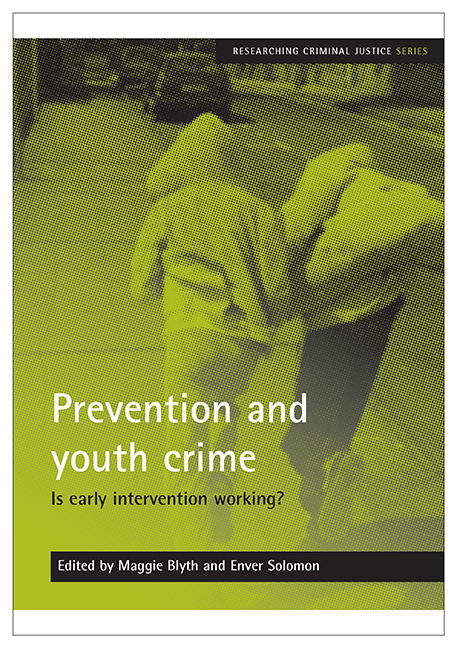Book contents
- Frontmatter
- Contents
- Foreword
- Acknowledgements
- List of abbreviations
- Notes on contributors
- Introduction
- 1 Integrated or targeted youth support services: an essay on ‘prevention’
- 2 Intervening in gang-affected neighbourhoods
- 3 Family intervention projects and the efficacy of parenting interventions
- 4 Early intervention and prevention: lessons from the Sure Start programme
- 5 Attachment research and the origins of violence: a story of damaged brains and damaged minds
- 6 Early intervention in the youth justice sphere: a knowledge-based critique
- 7 European perspectives on prevention
- Conclusion
Introduction
Published online by Cambridge University Press: 25 March 2023
- Frontmatter
- Contents
- Foreword
- Acknowledgements
- List of abbreviations
- Notes on contributors
- Introduction
- 1 Integrated or targeted youth support services: an essay on ‘prevention’
- 2 Intervening in gang-affected neighbourhoods
- 3 Family intervention projects and the efficacy of parenting interventions
- 4 Early intervention and prevention: lessons from the Sure Start programme
- 5 Attachment research and the origins of violence: a story of damaged brains and damaged minds
- 6 Early intervention in the youth justice sphere: a knowledge-based critique
- 7 European perspectives on prevention
- Conclusion
Summary
Prevention rather than cure is the obvious, common-sense approach to dealing with any problem and it is unsurprising that criminal justice policy has been driven by such an ideal. Shortly after entering government in 1997, New Labour embarked on what was seen by many commentators as a more holistic preventative model than its predecessor Conservative government had utilised, with the establishment of Crime and Disorder Reduction Partnerships. The distinguished criminologist, David Garland, described it as a ‘preventive turn’, reflecting an ‘epistemological break’ with the past (Garland, 2000). Prevention strategies quickly became embedded in the work of Community Safety Plans within local authorities. Initially, much of the work focused on situational crime prevention. But more recently there has been a much greater focus on early intervention projects and initiatives to target particular individuals as early as possible. Inevitably, this has been directed at children and young people who are considered to be ‘at risk’ of becoming the prolific criminals of the future.
The initial early intervention programmes directed specifically at children and young people were developed by the Youth Justice Board (YJB). Indeed, the YJB's inaugural conference held in May 1999 was called ‘Catch them early’. Risk-based early intervention strategies were developed to be used by Youth Offending Teams (YOTs) to identify children on the cusp of crime. At the same time, social policy programmes, in particular Sure Start, were rolled out to provide early intervention support for families with preschool children living in deprived neighbourhoods. For Tony Blair, early intervention was considered to be a vital part of New Labour's social and criminal justice agendas. He took a personal interest in pushing forward the early intervention agenda, particularly towards the end of his premiership. In 2006 he gave two major speeches in which he made a strident case for extending the early intervention approach. Blair claimed that ‘you can detect and predict the children and families likely to go wrong’, arguing that ‘instead of waiting until the child goes off the rails, we should act early enough, with the right help, support and disciplined framework, to prevent it’ (Blair, 2006).
This volume brings together contributions from experts to critically examine government policy in relation to early intervention programmes that aim to support families and to prevent children and young people from offending.
- Type
- Chapter
- Information
- Prevention and Youth CrimeIs Early Intervention Working?, pp. 1 - 8Publisher: Bristol University PressPrint publication year: 2008

